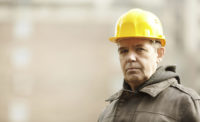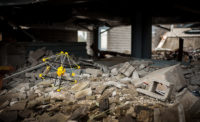The risks outdoors get greater as the days get shorter

Flying solo” on the job is one thing if you’re a telecommuter on a laptop in the warmth of your den; it’s something else entirely if you’re on the road delivering packages, trucking freight long haul, up on a telephone pole, digging a pipeline ditch, or driving hundreds of miles making sales call. And the cold temperatures; short daylight hours; and possible icy, snowy, windy conditions of winter compound all the potential risks faced by many lone workers.
What if you have a lone worker down in a 12-foot deep trench in freezing rain when the dirt walls give way?
What if a home healthcare aide is visiting patients on a day when a forecast of light snow turns into a storm dumping four to six inches of white stuff?
What if you have a lone worker in a telescoping boom bucket 30 feet from the ground when gale force winds unexpectedly whip up?
Working alone outdoors in winter months begs for task-specific risk assessments before sending lone workers on their way. The following risk assessment steps are based on recommendations from the Health and Safety Executive, the United Kingdom’s version of OSHA.
Assessing the risks
Your first step is to know who your lone workers are – there are many varieties. An employee might work from a fixed based, yes, their home, but also perhaps at a convenience store or gas station. Lone workers might be separate from others on the same premises, or work outside normal hours, such as security personnel or maintenance employees. They might spend most of their work hours outdoors on construction sites or in forestry, the postal service or farming jobs; or spend hours each day mobile and traveling about making deliveries, sales calls, driving transport vehicles such as buses and cabs, or providing home healthcare.
Next, identify the hazards of these lone worker jobs. This includes considering the nature of the work, type of clients or customers employees might contact or encounter; the places, locations, times and environments that are relevant; employee’s perceptions of their jobs and possible risks; and reviewing all incident reports, including near-misses.
|
After the clocks have been pushed back, the daylight hours dwindle, and the temperatures drop, add into your assessment the hazards of winter: ice; snow; sleet; freezing rain; strong winds; poor visibility; slips, trips and falls; increased odds of mechanical breakdowns; cold hands and feet; quick changing weather conditions; frozen water supplies; carbon monoxide from inadequately ventilated gas heaters; wet clothing; numb hands from using impact tools outdoors; etc.
Who might be harmed and how?
Your risk assessment review includes deciding who might be harmed and how when working alone, again, especially in the winter months. What type of injuries or ill health might occur? Vehicle crashes could be more prevalent in the short daylight hours or when poor weather ices or fogs windows and reduces visibility. Certainly the potential for outdoor slips, trips and falls increases when ice, snow or slush cover sidewalks and parking lots, loading docks and construction sites.
Evaluate all the relevant risks to your lone workers and decide if your existing safety practices, including use of personal protective equipment, vehicle emergency kits, and your ability to monitor the whereabouts of workers, are sufficient or more needs to be done.
Extra precautions
In the winter, “more needs to be done” could mean safety footwear that is insulated and provides good traction; keeping the head, hands and feet insulated for warmth; using a base layer of protective clothing plus waterproof, insulated clothing; and using high-visibility protective clothing with reflective stripping. Training lone workers on specific winter hazards can be important if the risks they face are significant enough. Taking extra breaks to warm up if working outdoors should be a reminder. The importance of vehicle maintenance needs to be emphasized if your lone drivers face bad winter weather, road closures, and possible breakdowns. Vehicle emergency kits might be called for. Lights on all vehicles should be cleaned regularly to ensure visibility at all times. Are construction site or maintenance scaffolds protected against harsh weathering such as snow, ice and hail? Are you sure any water supplies at outdoor sites are protected against freezing? Do your lone workers know the company policy on when weather conditions become dangerous enough to bring outdoor work to a halt, or prevent work from starting up at the beginning of a shift?
What would happen if a lone worker slipped in the dark on an icy patch and broke his leg in a remote location? How do you “audit the trail” of lone workers, know where they are, communicate regularly, and know when they’re late returning from work or missing in action? Equipping outdoor lone workers with cell phones is almost a given in this day and age. There are also various lone worker tracking systems that can entail identity badges that carry a signal and use satellite tracking software; pushbutton “panic” alarms with warnings sent via wireless technology; walk-talkie headset-type systems; and GPS systems for following the movements of employees “flying solo.”
Once you have all “what if” scenarios mapped out, complete your risk assessment by designing an action plan for lone workers and communicating that information to them. Finally, as with any safety management system, your plan, protocols, and risk assessments should be monitored for performance compliance and reviewed regularly and changed as needed.
Looking for a reprint of this article?
From high-res PDFs to custom plaques, order your copy today!









